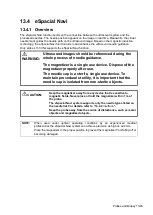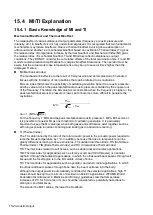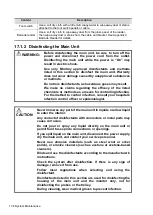
Acoustic Output 15-5
15.7.2 Limits of Acoustic Output
In accordance with the FDA Track 3 requirements, the derating (or attenuated) approach was
incorporated into the FDA Acoustic Output Limits, as listed below. The maximum acoustic output
level from any probe in any operating mode is expected to fall below these limits.
FDA Maximum Acoustic Output Limits for Track 3 (Attenuated Values)
Application
I
spta.3
(mW/cm
2
)
I
sppa.3
(W/cm
2
)
or
MI
Regions (except
eyes)
≤ 720
≤ 190
≤ 1.9
15.7.3 Differences between Actual and Displayed MI and TI
In operation, the system will display the Acoustic Output Parameters Thermal Index (TI) or
Mechanical Index (MI) (or sometimes both parameters simultaneously) to the operator. These
parameters were developed as general indicators of risk from either thermal or mechanical action
of the ultrasound wave. They serve to indicate to the operator whether a particular system setting
increases or decreases the possibility of Thermal or Mechanical effect. More specifically, they were
designed to assist in the implementation of the ALARA principle. As an operator changes a given
system control, the potential effect of the change in output is indicated. However, the Thermal
Index is not the same as the raise in temperature in the body, for several reasons. First of all, in
order to provide a single display index, a number of simplifying assumptions had to be made. The
biggest assumption was the use of the attenuating formula described above, which is much lower
than the actual value for most tissues within the body. Scanning through muscle or organ tissue,
for example, will produce much higher attenuation than 0.3 dB/cm/MHz. Significant simplifications
were also made for the thermal properties of tissue. Therefore, scanning through highly-perfused
tissue, such as the heart or vasculature, will produce significantly less thermal effect than that
suggested by the Thermal Index.
Similarly, the Mechanical Index was derived to indicate the relative possibility of mechanical
(cavitation) effects. The MI is based on the derated peak rarefactional pressure and the center
frequency of the ultrasound wave. The actual peak rarefactional pressure is affected by the actual
attenuation caused by tissue in the path between the probe and the focal point. Again, all solid
tissues within the body have higher attenuation than the prescribed 0.3 dB/cm/MHz value, and
therefore, the actual peak rarefactional pressure will be lower. Further, the actual peak
rarefactional pressure will change depending on the region of the body being scanned.
For these reasons, the TI and MI displays should only be used to assist the operator in
implementing ALARA at the time of the patient examination.
15.8 Measurement Uncertainty
The total estimated measurement uncertainty (where the total uncertainty includes uncertainties in
hydrophone response, measurement, calculation and positioning) are:
Ispta
28.5%
Isppa
28.5%
Center frequency (fc)
2%
Total power (W)
28.5 % (5.1% for Scan-mode and Combined-mode)
Rarefactional pressure (pr) 14.7%
Summary of Contents for TE5
Page 1: ...TE7 TE5 Diagnostic Ultrasound System Operator s Manual Basic Volume ...
Page 2: ......
Page 6: ......
Page 12: ......
Page 24: ......
Page 36: ......
Page 54: ......
Page 110: ......
Page 115: ...Display Cine Review 6 5 6 Tap Return on the screen or tap Freeze to exit image compare ...
Page 120: ......
Page 124: ......
Page 156: ......
Page 174: ......
Page 192: ...12 18 Setup Select Advanced and do as follows Select MAPS and do as follows ...
Page 202: ...13 2 Probes and Biopsy C5 2s L12 4s L7 3s P4 2s L14 6s C11 3s L14 6Ns V11 3Ws P7 3Ts 7LT4s ...
Page 226: ...13 26 Probes and Biopsy NGB 034 NGB 035 ...
Page 250: ......
Page 272: ......
Page 276: ...A 4 Wireless LAN Tap Add Manually create a network profile to set ...
Page 282: ......
Page 318: ......
Page 322: ......
Page 323: ...P N 046 006959 07 1 0 ...
















































